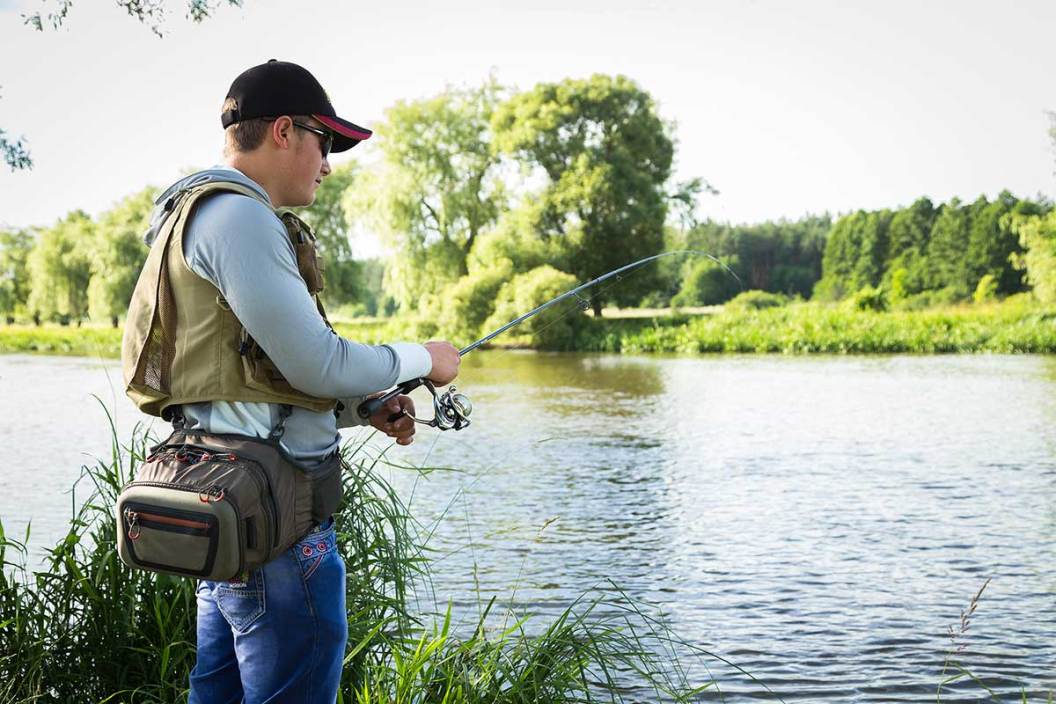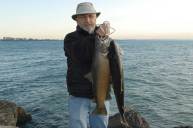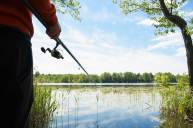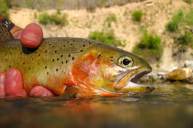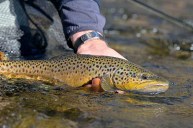Here are some tips for getting a jump on river fishing.
Finding fish in a river should obviously start by identifying the species you want to target as many rivers hold good numbers of different breeds of fish including largemouth bass, smallmouth bass, catfish, pike, muskie, and even sturgeon. Each fish has its own favorite haunts in a river as opposed to the stiller waters of a lake or impoundment.
Since there are thousands of rivers and river systems in North America and they all have their own differences and makeups, we'll try to break it down into a more simplified way of looking at things.
River fish have a distinctive means of living. The moving water systems they live in have a way of rising and falling that is typical of flowing water. Rivers can be extremely large and move tons of water like the vaunted St. Lawrence River in upper New York State, the Mighty Mississippi, or the famed Missouri River. Alternatively, some parts of rivers can be a fraction of those sizes, merely ankle deep, and with barely a trickle of flow.
But one thing that all rivers have in common is potentially good fishing, if you know where to look and what to do.
River Fishing 101
Fishing in streams and rivers offers different challenges than fishing in lakes and impoundments, mainly because anglers must deal with moving water. River fishing means knowing how to identify and locate the different parts and how fish behave in those areas. Fish prefer feeding areas near the outside of bends, merging currents, drop-offs, and feeder tributaries since they can find rest in the off-current spaces below the water to ambush prey.
Fruitful areas include obvious undercut banks, eddies provided by large rocks, sunken trees, and overhanging trees and bushes which provide protection from the current and even above-water predators. These locations can be much deeper than they look to the naked eye and slower below the surface than it appears above. Not only that, but these areas change from year to year as the water's current relentlessly works on the land and the surrounding fauna.
Overhanging Trees
In areas where overhanging trees and bushes provide shade, fish will prefer the cover of the branches to keep out the sunlight and give them a good vantage point for not only seeing prey, but detecting danger as well. Many areas like these are simply too shallow to hold larger fish, but as we've all found out over the years, ignore it and risk missing a fish that was resting there.
Undercut Banks
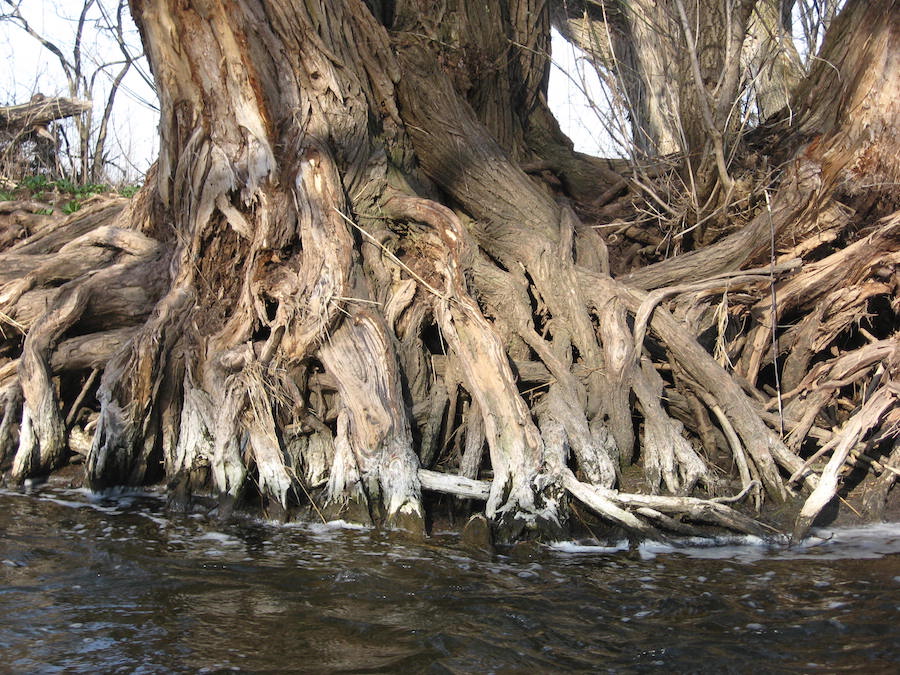
Craig Raleigh
Undercut banks are perfect hiding spots for fish on a river. They occur in areas where the river's current has cut out a hidden trench or groove along the bank from many years of rising and falling water levels. They provide overhead cover and easy access to deeper water for feeding or escape.
The largest fish in a river often reside in undercut banks due to the fact that they yield cover and offer a flow that brings with it a constant supply of prey.
Waterfalls and Digger Dams
In some areas where trout fishing restoration is occurring, digger dams are created to provide the water flow with another way to cut into the river bottom to create breaks in the current. These flows provide falling water which creates a "bubble curtain" that fish can hide in to obscure them from above water predators.
As fish move upstream against the current, dams or falls can prevent them from moving further. This can concentrate fish, making dams, waterfalls, and spillways great places for production.
Merging Currents
In areas where a river splits then comes back together, or where a tributary of another water flow meets the river, it has the effect of creating a seam where the two currents meet. This gives fish a great place to hunt in two specific flows which can provide more opportunity to feed successfully. Fishing in a merging current is a good way to go.
Boulders and Eddies
When large obstructing objects such as a boulder or a downed tree break the current, the areas just downstream of that object are ideal for holding fish. In rivers with a heavy current, this can slow down that current and make a great ambush spot for fish, as well as a place to hide that is out of the main current.
Sometimes these areas are right in the center of a river, and sometimes they are created on the edge of the bank and can cause a great whirlpool effect. This is a spot where fish can rest, feed, and even spawn if the timing's right. In other words, they're some of the most promising parts of a river for anglers.
River Bends
River bends cause undercut banks, changes in the current flow, and submerged trees and boulders over the years. Since the faster water moves to the outside of the bend, fish congregate in these areas to feed. If the spots contain a tree or rock, it both slows down the food-carrying current and provides shelter making it a great place to fish.
River Fishing Tips
As stated, there are differences between smallmouth bass fishing on the Delaware River, catfish fishing on the Allegheny River in Pennsylvania, and brown trout fishing on the Yellowstone River in Montana. Each species, time of year, and location weighs into the river's potential for good fishing. Ideally you need to identify a current seam or boulder or bank contour as the focal point of your presentation.
Rivers are all about flow, and moving water forces fish to react faster than they would on a lake or other calmer water. Fish in a river system don't always have the luxury of waiting on a bait since the current can and will take prey away from them in an instant.
Sure, when you're trout fishing you're still going to need to match the hatch, but that doesn't mean that a fat football-shaped brown trout won't demolish a jointed Rapala that's placed right in front of him. River fishing is about change, and nothing changes quite like rivers.
It's also about the need to constantly adapt what you're doing to meet the changes in the particular river that you're fishing. Shifting variables such as size, color, and speed of your presentation can make a big difference. And just because you've struck out on a spot the last few times that you fished it doesn't mean you should never fish it again. Fish adapt and move around on rivers, and that undercut bank might now be home to the next big flathead catfish after time went by.
River Fishing Methodologies
When fishing eddies and current seams, one day the bite will come on a Ned rig or other soft plastic bait worked through the water flow, and the next time out it may be a stickbait that does the trick. The usual method of fishing around a boulder in the current is to cast past it and bring your offering gently around the big rock on one side or the other. Many times I like to mix this up by standing at almost a right angle to the rock and ripping my bait through the current break behind it from a different direction.
When fishing an undercut bank the best method is to cast beyond the start of the cut and bring it back with the current to let it hang right in the fish's face. A great piece of advice I received long ago was that many times the most aggressively-feeding fish sit at the back-most edge of these areas, so don't be afraid to approach from the far rear of the hole and start there. This can be especially true for rainbow trout and steelhead fishing.
Veteran river fishermen swear by having a good pair of polarized sunglasses at the ready to identify obvious underwater structure, current breaks, and even fish. It is also their recommendation that you use lens colors in the amber or silver mirror realm for moving water conditions, but really any polarized glasses are better than none.
This is great option for bottom bouncing live bait, especially live bait tipped on a jig. In cases where the motion of the water is great enough to disturb your vision, you'll have to fish it in much the same way that you would on a lake: by feel. While this is true for river fishing, there are many times you will be able to see your bait as it makes its way through the current to obvious strike zone areas. This gives you a chance to work it in such a way as to keep it in the strike zone longer or even to see the reaction of a fish that is there.
In other words, a fish may flash at one offering, but seeing that action can give you immediate feedback. Try to change up and offer another variation, and chances are that fish will demolish it.
Another great idea is to find some uncommon areas of structure that stick out, such as a distinct weed line or an island. Since weed lines aren't very common in some rivers, if you can locate a calm area that has weed growth, then you've most likely found a prime fishing location.
Islands are essentially giant current breaks that disrupt the water flow. When this happens on larger rivers, it is also common that there will be a distinct drop off that will be especially prime spots for any bass in the area.
Biggest Things to Remember About River Fishing
As a freshwater fishery goes, rivers can be one of the most productive places to fish, even outpacing other waterways. It doesn't matter if you're boating, using waders, or even kayak fishing, rivers can be great angling hotbeds. But the inherent dangers need to be recognized, too.
Esteemed locations such as the Mississippi and the Missouri Rivers can be dangerous enough, but two of the most famous fishing rivers in the United States are the St. Lawrence River and the Upper Niagara River, down river of which is Niagara Falls! Fishing shouldn't ever get in the way of practicing responsibility, so make sure you're familiar with the rules and regulations, as well as the current and potential conditions. Staying safe is the most important thing. Catching fish is a close second.
The fishing skills needed on rivers are not completely different from any other type of fishing, but they need a shifted perspective in terms of planning and an understanding of the area. Rivers are just as famous for fly fishing calm backwaters that hold fish as much as they are for open water and clear water areas that provide the best traditional fishing. They present a lot of opportunities, but you need to know what you're getting yourself into.
Anglers fishing in rivers can use worms, minnows, and cut bait just as casting spinners, jigs, and curly tail grubs anywhere and have great success. Don't be afraid to talk to the folks at the local tackle shops for information. Sure, they want to sell bait and other gear, but they won't steer you wrong because they want you to be successful so that you'll come back!
Looking for a little more or even hot lunch for your hunting blind? Follow my webpage, or on Facebook and YouTube.
NEXT: LOVE 'A RIVER RUNS THROUGH IT'? THEN VISIT THESE LOCATIONS WHERE IT WAS FILMED
